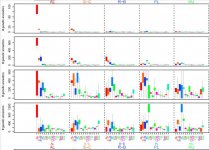Piro Ilir
Regular Member
- Messages
- 1,155
- Reaction score
- 92
- Points
- 0
Even the school kids know that Albanian is a separate branch of IE. Serious scholars arguing that proto Albanians before coming in west Balkans were neighbors with proto Baltic people. Albanian have some connections with Baltic languages, but it's a completely distinct branch. Albanian language have archaic doric loans, north west greek loans, archaic Latin loans, east romance loans, west romance loans. So you are again wrong sir. And all this is going to be boring, because I really think you know all those facts. [emoji57] . Albanian have both West and east vulgar Latin word loans, but the loans of east made up the majority of vulgar Latin. If Albanians came so late in Balkans how they have all those archaic words in their language, and the Slavs don't. And even the vlachs don't have archaic Latin words. Albanians have ancient doric loans by the colonies on the coast (Corcyra). They are indigenous there, and you know it, so stop with your claims, because none is believing you [emoji57]. Probably they are more indigenous than Greeks if you see carefully their DNA, unfortunately .This is your opinion.
No, it is not silly. On the contrary. One of theory is that Albanian created in 4-6 century in Romania. You probably know for Baltic theory and that Albanian is the branch of Balto Slavic. In the video which your college gave you can see that Albanian originate from Balto-Slavic. Albanian has similarities as Balto-Slavic languages, do you know it. And you probably know that Latin words in Albanian came from Romanian (Eastern variant) not from Dalamatian (Western variant). Etc.
But your college and I have other discussion about New Zealand scientists, who give the model in which Albanian has root as Iranian and Indic languages. And according it Proto Albanian could be in the Caucasus or near. According them Greek and Armenian have same root, and Albanian and Iranian and Indic languages same root. Albanian has some familiarity with Armenian, but if their model is appropriate, more with Iranian/Indic. These scientists are very cited, their model is new, and different from traditional model. Yes, they claim about Anatolian hypothesis, that Proto Indo European originated in Anatolia (contrary from Kurgan hypothesis).
If they are right it is possible that movement of Proto Albanian speakers people were: Caucasus-area near Black Sea-South Ukraine/Moldavia/Romania. There are people in this forum who pointed this. We will see new scientific findings. For now, for me it can be interesting new paper forthcoming:
BALKAN GENETIC SIGNALS IN THE ARMENIAN PATERNAL GENE POOL
http://www.isabs.hr/registration201...iew&id_program=20&id_topic=53&id_abstract=365
From Abstract:
On the whole, our results only partly support the version of Balkan origin of the Armenians, and in contrast to it, mainly indicated Neolithic and post-Neolithic ancient human migrations from the Armenian Highland and the Levant to southern Europe.
[emoji562]






